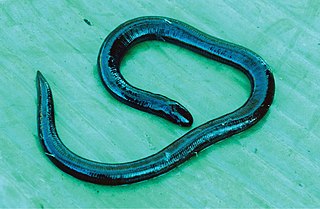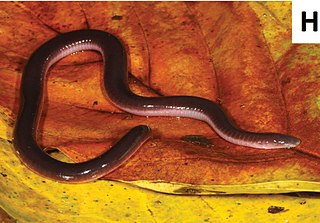
Caecilians are a group of limbless, vermiform or serpentine amphibians. They mostly live hidden in the ground and in stream substrates, making them the least familiar order of amphibians. Caecilians are mostly distributed in the tropics of South and Central America, Africa, and southern Asia. Their diet consists of small subterranean creatures such as earthworms.
Nectophrynoides laevis, the smooth forest toad, is a species of toad in the family Bufonidae.
Nectophrynoides minutus is a species of toad in the family Bufonidae. It is endemic to Tanzania and is known from the Uluguru and Rubeho Mountains. Common names small viviparous toad, minute tree toad, and dwarf forest toad have been proposed for it.
Nectophrynoides pseudotornieri is a species of toad in the family Bufonidae. It is endemic to the Uluguru Mountains in eastern Tanzania. Common names pseudo forest toad and false Tornier's viviparous toad have been proposed for it. Its specific name refers to its similarity to Nectophrynoides tornieri.
Boulengerula fischeri is a species of caecilian in the family Herpelidae. It is endemic to Rwanda and only known from around its type locality near Cyangugu, southwestern Rwanda. The specific name fischeri honours Eberhard Fischer, a German botanist who has worked with Rwandan fauna and flora. Common name Fischer's African caecilian has been coined for it. Live animals have the appearance of "live pink spaghetti".
Boulengerula uluguruensis, the Uluguru pink caecilian or Uluguru African caecilian, is a species of amphibian in the family Caeciliidae. It is endemic to Tanzania where it is found in the Nguu, Nguru, and Uluguru Mountains. Its natural habitats are subtropical or tropical moist lowland forests, subtropical or tropical moist montane forests, rural gardens, and heavily degraded former forest.
Sylvacaecilia is a monotypic genus of caecilian in the family Grandisoniidae. The only species is Sylvacaecilia grandisonae, also known as the Aleku caecilian or Ethiopian caecilian. It is endemic to southwestern Ethiopia and known from the Gambela, Oromia, and Southern Nations, Nationalities, and Peoples' Regions.
Afrixalus uluguruensis is a species of frog in the family Hyperoliidae. Its common name is Uluguru banana frog. It is endemic to the Eastern Arc Mountains of Tanzania and known from the Kipengere Range, Mahenge, Udzungwa Scarp, Rubeho, North Uluguru, Nguru, Ukaguru, and Nguu Mountains.

Hyperolius tanneri is a species of frogs in the family Hyperoliidae. It is endemic to the West Usambara Mountains in northeastern Tanzania. Common name Tanner's reed frog has been coined for this species.

Leptopelis parkeri is a species of frog in the family Arthroleptidae. It is endemic to Tanzania and known from the Eastern Arc Mountains. Specifically, it has been recorded from Uluguru, Udzungwa, East and West Usambara, Nguru, and South Pare Mountains. Common names Parker's tree frog and Parker's forest treefrog have been coined for it. It is named after Hampton Wildman Parker, a British zoologist and herpetologist from the Natural History Museum, London.

The Uluguru forest tree frog or ruby-eyed tree frog, Leptopelis uluguruensis, is a species of frog in the family Arthroleptidae endemic to Tanzania. Its natural habitats are subtropical or tropical moist lowland forest, subtropical or tropical moist montane forest, rivers, and intermittent freshwater marshes. It is threatened by habitat loss.

Ichthyophis glutinosus, the Ceylon caecilian or common yellow-banded caecilian, is a species of caecilian in the family Ichthyophiidae endemic to Sri Lanka. Its natural habitats are moist tropical and subtropical forests and pastures.

Ichthyophis mindanaoensis, also known as Todaya caecilian or Mindanao Island caecilian, is a species of caecilian in the family Ichthyophiidae. It is endemic to the island of Mindanao, the Philippines.
The Uluguru blue-bellied frog is a species of frog in the family Microhylidae. It is endemic to Tanzania. Its natural habitats are subtropical or tropical moist lowland forests and subtropical or tropical moist montane forests. It is threatened by habitat loss.
Parhoplophryne is a monotypic frog genus in the family Microhylidae. The sole species is Parhoplophryne usambarica, sometimes known as the Usambara black-banded frog or Amani forest frog. It is endemic to the East Usambara Mountains in Tanzania. It is only known from one specimen collected in the 1920s and is feared to be extinct.
Probreviceps uluguruensis is a species of frog in the family Brevicipitidae. It is endemic to the Uluguru Mountains, Tanzania. Common names Uluguru big-fingered frog and Uluguru forest frog have been proposed for it.
Phrynobatrachus uzungwensis is a species of frogs in the family Phrynobatrachidae. It is endemic to eastern Tanzania and is known from the Udzungwa, Uluguru, Nguu, and Nguru Mountains. Common names Ukinga puddle frog and Udzungwa puddle frog have been coined for this species.
Rhinatrema nigrum, the black caecilian, is a species of caecilian in the family Rhinatrematidae found in Guyana, Venezuela, and possibly Brazil. Its natural habitats are subtropical or tropical moist lowland forests, subtropical or tropical moist montane forests, rivers, and intermittent rivers.

Scolecomorphus kirkii is a species of caecilian in the family Scolecomorphidae. It is known from southern Malawi east of the Shire River, northern Mozambique, and Tanzania ; the known distribution is discontinuous but the species is expected to occur in the intervening areas.
Scolecomorphus vittatus, the banded caecilian, is a species of caecilian in the family Scolecomorphidae, endemic to Tanzania. Its natural habitats are subtropical or tropical moist lowland forests, subtropical or tropical moist montane forests, plantations, rural gardens, and heavily degraded former forests.







